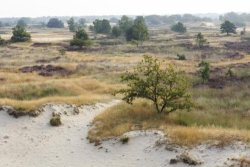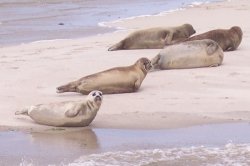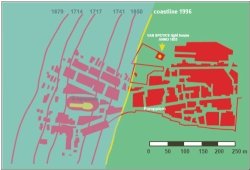List of National Parks in the Netherlands
- Details
- Category: Geography

National parks in the Netherlands were defined in the 1960s as areas of at least 10 km² consisting of natural terrains, water and/or forests, with a special landscape and flora and fauna.
Visit Holland or Visit the Netherlands?
- Details
- Category: Geography
The official name of the country is the Netherlands. In the rest of the world, the name Holland is commonly used for the entire country. However, when used correctly, the name Holland only refers to the area covered by the provinces of North and South Holland.
Narure in the Netherands
- Details
- Category: Geography

The Netherlands has 20 national parks and hundreds of other nature reserves, that include lakes, heathland, woods, dunes and other habitats. Most of these are owned by Staatsbosbeheer, the national department for forestry and nature conservation and Natuurmonumenten (literally 'Natures monuments'), a private organisation that buys, protects and manages nature reserves.
Netherlands - dominated by water
- Details
- Category: Geography
Geography The Netherlands is one of the most densely populated countries in the world. No matter where you go, you are never far away from civilization. Cities can be crowded especially in the Randstad area, where congestion is a serious problem.
Holland - the coastline
- Details
- Category: Geography

The Dutch coast consists of sandy, multi-barred beaches and can be characterised as a wave-dominated coast. Approximately 290 km of the coast consists of dunes and 60 km is protected by structures such as dikes and dams. With the melting of the ice at the end of the last ice age the coastline shifted eastward until about 5000 years ago the present position of the Dutch coastline was reached.
Municipalities of the Netherlands
- Details
- Category: Geography
This is a table of municipalities of the Netherlands on January 1, 2012. From Wikipedia, the free encyclopedia
Reclamation of the land
- Details
- Category: Geography
The land that is now Holland had never been stable. Over the millennia the geography of the region had been dynamic. The western coastline shifted up to thirty kilometres to the east and storm surges regularly broke through the row of coastal dunes. The Frisian Isles, originally joined to the mainland, became detached islands in the north. The main rivers, the Rhine and the Meuse (Maas), flooded regularly and changed course repeatedly and dramatically.
Rivers
- Details
- Category: Geography
All of the Netherlands is drained into the North Sea, partly via the IJsselmeer lake. In the list below, rivers that flow into the sea are sorted following the North Sea coast (including IJsselmeer) from the Belgian border near Knokke to the German border near Emden.
Visit Holland, land of water
- Details
- Category: Geography
Holland is rich in water and is well- known for its expertise with regards to water management. Due to its location on the north-sea and all the inland waterways, water has also brought Holland a lot of prosperity. It is often said that water is flowing through the veins of the Dutch.
Administrative divisions in Netherlands
- Details
- Category: Geography
Administrative divisions The Netherlands is divided into twelve administrative regions, called provinces, each under a Governor, who is called Commissaris van de Koningin (Commissioner of the Queen), except for the province Limburg where the commissioner is called Gouverneur (Governor).
Top 10 cities in the Netherlands
- Details
- Category: Geography
The Netherlands has many cities and towns of interest to travellers. Below are the top 10 of the most notable ones....
Caribbean Netherlands
- Details
- Category: Geography
The Caribbean Netherlands (Dutch: Caribisch Nederland) refers to a group of three special municipalities of the Netherlands (officially public bodies) that are located in the Caribbean Sea: the islands of Bonaire, Sint Eustatius, and Saba,which are also known as the BES islands.
Regions in the Netherlands
- Details
- Category: Geography
The Netherlands is a constitutional monarchy, administratively divided into 12 provinces (provincies). Even though the Netherlands is a small country, these provinces are quite diverse and have plenty of cultural and linguistic differences.
List of islands of the Netherlands
- Details
- Category: Geography
This is a list of islands of the Kingdom of the Netherlands.
Living with the water in the Netherlands
- Details
- Category: Geography
Oosterscheldekering, part of the Delta Works The Dutch are famous for their struggle with the sea. As a former naval power, the Netherlands owed its 17th century Golden Age to the water, and still depends heavily on it for modern day trade and fisheries, as the massive, modern port of Rotterdam demonstrates.
Some geography facts
- Details
- Category: Geography
The geography of the European part of Netherlands is in that much of its land has been reclaimed from the sea and is below sea level, protected by dikes.
Historic cities in the Netherlands
- Details
- Category: Geography
Wandering through the magnificent city of Amsterdam, with its lovely canals and hundreds of 17th century monuments, is a delightful experience. For most people, a visit to the Netherlands would not be complete without a good day in its bustling capital.
Extreme points of the Netherlands
- Details
- Category: Geography
This is a list of the extreme points of the Netherlands, the points that are farther north, south, east or west than any other location.
Latest articles
- Accommodatie Eurovisie Songfestival 2020 - Rotterdam
- Vermeer - famous Dutch painter from Delft
- Delft - Oude Kerk - Old Church
- Delft
- Enkhuizen - Havenweg - streetview - Google Maps
- Alkmaar - cheese market - Waagplein - streetview - Google Maps
- Hoorn - city center - Roode Steen - streetview - Google Maps
- Veere - Townhall - streetview - Google Maps
- Middelburg - Townhall - streetview - Google Maps
- Vlissingen - Smallekade - streetview - Google Maps
- Zierikzee- streetview - Google Maps
- Oosterschelde- streetview - Google Maps
- Haringvlietdam - Haringvlietsluis - streetview - Google Maps
- Hollands Diep - streetview - Google Maps
- Moerdijk bridges - streetview - Google Maps
- Harlingen - streetview - Google Maps
- Stavoren - streetview
- Dokkum - streetview
- Giethoorn - streetview
- Claire Morgan The Sound of Silence - Noord Brabants Museum
Visitors for Visitholland
We have 95 guests and no members online

